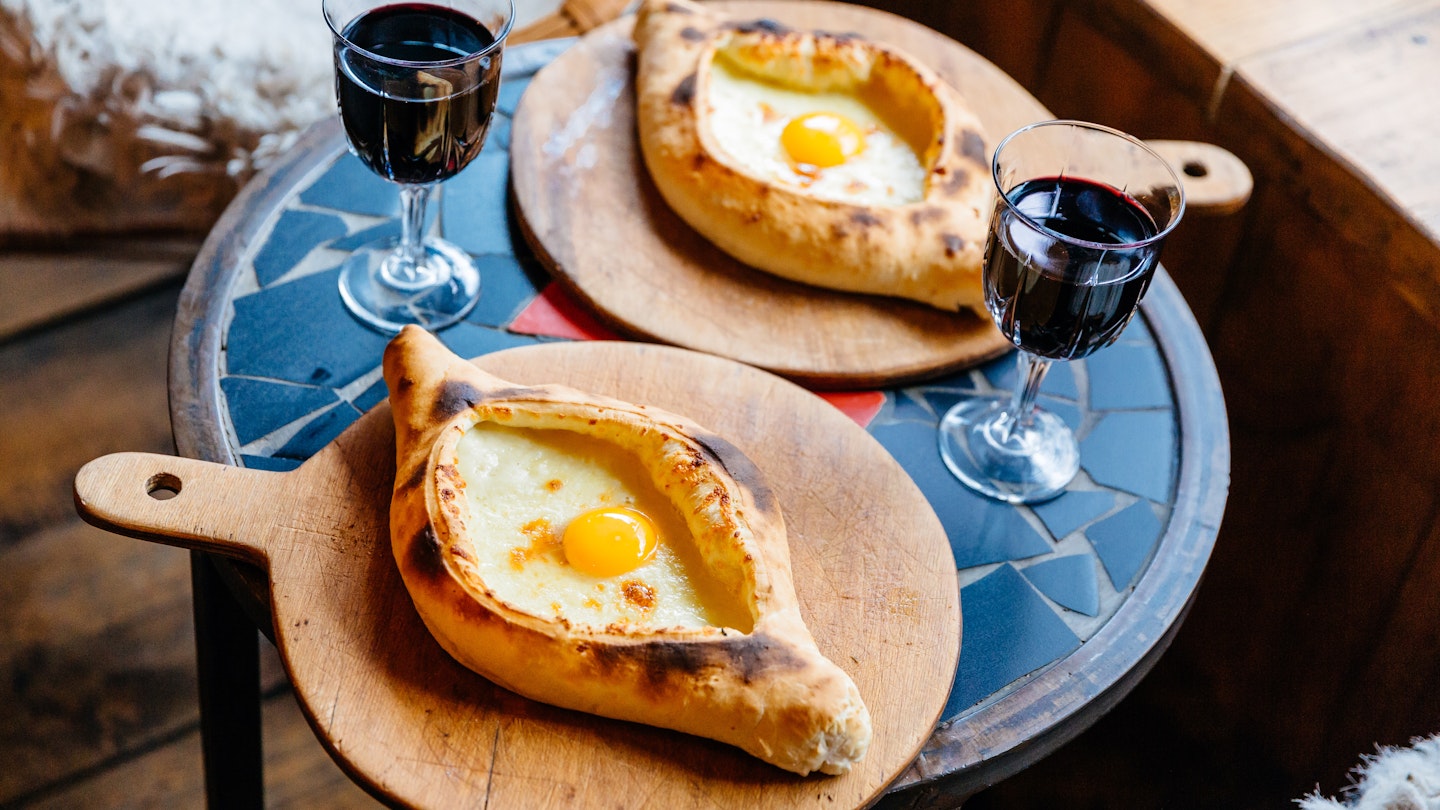
Spanning the Silk Road between Europe and Asia, there’s a solid argument to consider Georgian food the world’s original fusion cuisine. Across the centuries, traders and armies transited both east and west through this compact area bordered by the Black Sea, where the culinary influence of historical empires, including the Mongols, Ottomans, and Persians, lingers in Georgian kitchens.
Understanding Georgia’s Key Ingredients
Negotiating Tbilisi’s Deserters’ Market is a fascinating way to discover the fundamental ingredients that define Georgian cuisine. Named after deserters from the army who sold their equipment here in the 1920s, this market is a gritty and authentic affair packed with the freshest produce. Walnuts and pomegranates sit next to colorful plastic buckets overflowing with vibrantly-hued spices.
In the dairy section, tubs of velvety matsoni (Georgian yoghurt) compete with chunky shards of briny white Sulguni cheese, although be cautious as the quality can vary, with some made from milk powder rather than real milk. Crouching on stout stools, Azeri traders offer fresh herbs, featuring the Georgian essentials of dill and tarragon. Meanwhile, butchers upstairs cut meat to order—lamb, pork, and veal—perfect for hearty stews, dumplings, or grilled mtsvadi-style over charcoal.
Family-owned stalls present knobbly strings of churchkhela, made from nuts dipped in an unctuous syrup of grapes, with plastic water bottles repurposed for homemade sour and spicy sauces.

Classic Georgian Dishes
Khinkali, regarded as Georgia’s unofficial national dish, is a boiled dumpling filled with meat, cheese, or vegetables. The proper way to enjoy khinkali is by dusting it with black pepper, picking it up by hand, and carefully slurping the delicious broth before savoring the tender dumpling.
Traveling east along ancient trade routes, one finds that khinkali bears a resemblance to Shanghai’s renowned soup dumplings. Various regions in Georgia put their unique spin on khachapuri (cheese-filled pies), while the boat-shaped adjaruli khachapuri, crowned with melted butter and an egg, has become a national favorite from the country’s western region. To enjoy it fully, mix the filling, break off the bread’s pastry handles, and dip them into the molten mixture. Another delightful dish is chakapuli, which is a fragrant lamb stew seasoned with dill, tarragon, and sour plums, showcasing the distinct influence of neighboring Iran.
Neighborhood bakeries rise early to create fluffy flatbreads baked on the curved clay walls of a tone, similar to an Indian tandoor. The yeasty aroma of fresh bread is one of Tbilisi’s signature scents. Visit Keria bakery to sample lobiani, a flaky flatbread filled with smoky spiced beans.
Where to Eat in Tbilisi
Rustic restaurants serving khinkali are plentiful in Tbilisi, though a few establishments stand out. Try Pasanauri located at Old Town’s Gorgasali Sq (previously Maidan Sq), as well as the semi-basement Klike’s Khinkali, known for a unique variety made from sun-dried ham, and Zodiago for its nadughi (ricotta-like cheese) khinkali. Typically, a minimum order of five dumplings is expected.
For a crispy crust of adjaruli khachapuri, visit Café Stamba, or head to Puri Guliani next to Moxy by Marriott at Dry Bridge for traditional khachapuri. For an intriguing insight into Georgian culinary history, Barbarestan features a menu inspired by a cookbook from a 19th-century noblewoman, Barbara Jorjadze. Standout dishes include eggplant in walnut sauce and an array of dips paired with crunchy wafer-thin lavash bread, reflecting flavors from neighboring countries, including Turkey, Armenia, and Iran.
The ‘New Georgian’ Culinary Wave
While Tbilisi’s dining landscape is deeply rooted in tradition, a new wave of restaurants is emerging, offering innovative takes on local flavors. Led by Georgian chef Tekuna Gachechiladze, Cafe Littera in Sololaki and Culinarium Khasheria in Abanotubani provide a delightful fusion of traditional Georgian and Mediterranean dishes. Restaurant Meama, under another talented Georgian chef, Levan Kobiashvili, is a fantastic spot to try modern twists on traditional and regional meals. Shavi Lomi, a local favorite, is noted for its bold and adventurous menu, featuring dishes such as khachapuri with aged mountain cheese, lamb chakapuli, and fried chicken in blackberry sauce.
Culinary Tours and Cooking Schools
To truly immerse yourself in the richness of Georgian cuisine, participating in culinary tours organized by locals is an excellent option. Tbilisi-based companies like Living Roots specialize in crafting authentic, customized culinary experiences, including journeys to vineyards across the country. Additionally, Chef Tekuna’s Culinarium Cooking School provides an opportunity to learn the fundamentals of Georgian cooking from various local chefs in one of Tbilisi’s oldest neighborhoods.
Article first published in July 2016 and last updated by Baia Dzagnidze in January 2020.
This article was first published Jul 8, 2016, and updated Jan 20, 2020.





